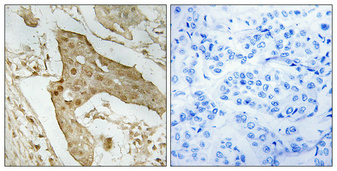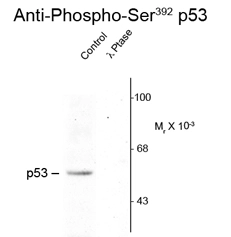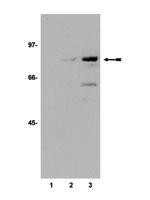
The data was published in the journal PLoS One in 2017. PMID: 29045486
p53 antibody [B20.1 (BP 53.122)]
GTX28590
ApplicationsWestern Blot, ImmunoHistoChemistry, ImmunoHistoChemistry Paraffin
Product group Antibodies
TargetTP53
Overview
- SupplierGeneTex
- Product Namep53 antibody [B20.1 (BP 53.122)]
- Delivery Days Customer9
- Application Supplier NoteThis antibody can be used on formalin-fixed, paraffin-embedded tissue sections at a dilution of 1:50-1:75 . Heat mediated antigen retrieval is strongly recommended for consistent and reproducible results. For western blotting use at 1:100-1:250.This antibody is not suitable for frozen tissue sections. The optimal conditions should be determined by the individual laboratory.
- ApplicationsWestern Blot, ImmunoHistoChemistry, ImmunoHistoChemistry Paraffin
- CertificationResearch Use Only
- ClonalityMonoclonal
- Clone IDB20.1 (BP 53.122)
- Concentration0.35 mg/ml
- ConjugateUnconjugated
- Gene ID7157
- Target nameTP53
- Target descriptiontumor protein p53
- Target synonymsantigen NY-CO-13; BCC7; BMFS5; cellular tumor antigen p53; LFS1; mutant tumor protein 53; P53; p53 tumor suppressor; phosphoprotein p53; transformation-related protein 53; TRP53; tumor protein 53; tumor supressor p53
- HostMouse
- IsotypeIgG2a
- Protein IDP04637
- Protein NameCellular tumor antigen p53
- Scientific DescriptionThis gene encodes a tumor suppressor protein containing transcriptional activation, DNA binding, and oligomerization domains. The encoded protein responds to diverse cellular stresses to regulate expression of target genes, thereby inducing cell cycle arrest, apoptosis, senescence, DNA repair, or changes in metabolism. Mutations in this gene are associated with a variety of human cancers, including hereditary cancers such as Li-Fraumeni syndrome. Alternative splicing of this gene and the use of alternate promoters result in multiple transcript variants and isoforms. Additional isoforms have also been shown to result from the use of alternate translation initiation codons from identical transcript variants (PMIDs: 12032546, 20937277). [provided by RefSeq, Dec 2016]
- Storage Instruction2°C to 8°C
- UNSPSC12352203
References
- Effective Combined Photodynamic Therapy with Lipid Platinum Chloride Nanoparticles Therapies of Oral Squamous Carcinoma Tumor Inhibition. Gusti-Ngurah-Putu EP et al., 2019 Dec 2, J Clin MedRead more
- Thiamine deficiency activates hypoxia inducible factor-1alpha to facilitate pro-apoptotic responses in mouse primary astrocytes. Zera K et al., 2017, PLoS OneRead more




![ICC/IF analysis of HeLa cells using GTX27757 p53 antibody [BP53-12].](https://www.genetex.com/upload/website/prouct_img/normal/GTX27757/GTX27757_20191025_AP_002_194_w_23060722_732.webp)

